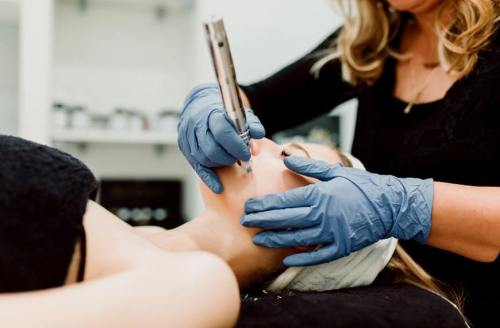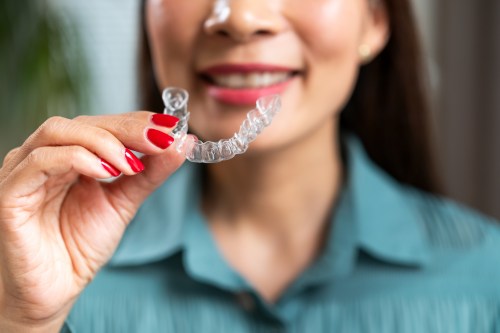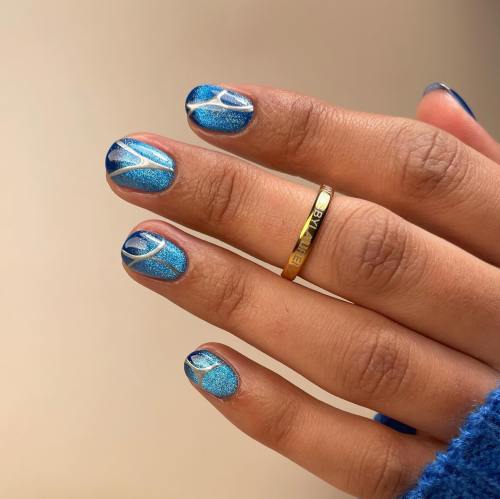“Is it cancer?” I ask my dermatologist, pointing to the fiery red mole that’s cropped up on my chest seemingly overnight. “No, she says. “It’s just age.” Oof.
If you thought weird skin issues were just for grandpas, you’re mistaken. It turns out that once you push past your twenties, all sorts of oddities can begin to appear on your epidermis. According to New York City dermatologist Joshua Zeichner, MD, you shouldn’t actually get any new traditional moles after the time you’re 30. But, if you notice that you have new ones or your existing moles start growing or shape-shifting, he says to make sure to check with a dermatologist to make sure it’s nothing worrisome.
Aside from that, there are some totally normal (I repeat: totally normal) skin-care conditions that pop up. Below, dermatologists give me the rundown on what’s what in the world of strange skin things that might bother you but shouldn’t worry you, including my red mole (AKA cherry angioma), skin tags, and more.
Sh*t’s getting weird—keep scrolling for the five non-threatening skin conditions that crop up with age.

Skin tags
If you find a little piece of skin that you feel as though you could pull off—but can’t—it’s a skin tag, says Danbury, Connecticut-based dermatologist Mona Gohara, MD. She tells me these charming developments can be genetic or, very rarely, that they can serve as a sign of increased blood sugar.
Skin tags appear with increasing frequency as you age, and NYC-based dermatologist Robert Anolik, MD offers an additional origin story which explains this phenomena. “A major reason for skin tags to appear is because skin rubs against other skin,” he says. “That’s why tags tend to show up in places like folds, creases, and areas that move quite a bit.” That means you’ll find them in places like the underarm, under the breasts, the groin, and around the neck (because it’s turning constantly). “Their development isn’t necessarily age-related but time-related, from skin chronically rubbing together and allowing them to form,” he explains. Jockeys, anyone?
While you can just leave them be—they’re benign, so no reason to worry—if your skin tags bother you, your best bet is to head to the dermatologist. “They’re very easy to remove,” says Dr. Gohara, who tells me that at the doctor’s office they just medically cut them off.
Cherry angiomas
Remember that red mole I told you about? It’s since multiplied—there are now too many on my body to count. Dr. Gohara tells me these are known as cherry angiomas, or benign growths comprised of a bundle of blood vessels. “They’re usually concentrated on your trunk—chest, abdomen, and back—but they can be anywhere,” she says, a claim to which I (and my newly-speckled body) can attest.
Cherry angiomas, like skin tags, tend to develop with age. “Everybody is going to have some of them by the time they’re sixty,” says Dr. Anolik. “But really, they start appearing much younger.” (Ahem: Like, after the age of 29!) At this point, no one really knows what causes them to form, though it’s likely that there’s a genetic component. “Usually when you identify one on someone, they’ll be like ‘My mom or dad have them, too,'” says Dr. Gohara. There’s also a possibility according to Dr. Anolik, however, that there’s a hormonal connection. “They tend to flourish in a lot of people during pregnancy and they can actually self-resolve to some degree after pregnancy, which is a major indicator of a hormonal driver,” he says. “Still, hormones aren’t the cause because plenty of men and also women in their post-menopausal years (without any hormone replacement therapy) get these, too.” So: Shrug emoji.
The good news (for me, as I’ve been unable to body-positive my way into loving these angry-looking red moles on my skin) is that they can be eradicated with relative ease. “I really enjoy lasering cherry angiomas because the response is extraordinarily quick and effective,” says Dr. Anolik. “The vast majority of the time, we laser it once and it’s gone a week later.” You can also, says Dr. Gohara, cauterize them with a hot electric needle, but “it’s more likely to leave scar,” she says.
Seborrheic keratoses
The sudden appearance of these brown spots (they look like clusters of elevated moles), says Dr. Gohara, often drives people to seek a dermatologist’s care, and rightfully so. “They’re afraid they have skin cancer,” she says. “[Seborrheic keratoses] are completely benign, but they’re one of the most common melanoma mimickers so they really freak people out.” Usually, she explains, they present as round, grey growths but they, like melanomas, can be irregular and have different colors or even be crusty. “Anytime you have a lesion like that, you should be evaluated,” Dr. Gohara advises. “But usually, you can almost pick them off, and that’s not the case with a melanoma.” (Get checked anyway!)
Both doctors tell me these are exceedingly common—they’re a part of what Dr. Gohara calls the “standard milieu of a 40-something person,” AKA a delightful mix of Seborrheic keratosis, cherry angiomas, and skin tags. No one really knows what causes them, I’m told, though both doctors say they’re primarily thought to be genetic. “[Some theorize] that there’s a viral component, like with a wart, because they grow like a wart, but that’s not been proven and they’re not contagious,” Dr. Anolik explains. “They do tend to favor sun-exposed areas, though they can be anywhere on the body.”
As unpleasant as it may sound, the solution for these cuties—which Dr. Anolik says people describe to him as “stuck-on warty brown bumps”—is to have them scraped off. “They are remarkably superficial skin growths, so they’re basically growing out of the epidermis,” he says. “And when you don’t disturb the dermis, the part of the skin right underneath the epidermis, the chance of you leaving a visible scar is extremely low.”
Sebaceous hyperplasia
Another very common thing which might develop with age, both docs tell me, is called Sebaceous hyperplasia, which is an enlarged oil gland. “These are tiny bumps that can have a whitish to yellowish hue and almost have a dimple in the middle,” explains Dr. Anolik. They tend to present on the face, he says, where there are a lot of sebaceous glands which can become overgrown. Though they may be seen more often in people with a rosacea background, Dr. Anolik tells me, they can appear on anybody…of a certain age. “You don’t see many teenagers or people in their 20s with sebaceous hyperplasia,” says Dr. Gohara.
Currently, therapy for sebaceous hyperplasia involves lightly cauterizing the surface to diminish their size, says Dr. Anolik. “This does mean that over months to years, each individual one that you shrink can reform because the base is still there under the skin,” says Dr. Anolik. “Still, the treatment is easy to do.” More effective lasers, he adds, are in the works.
Milia
These tiny white cysts, says Dr. Gohara, can look like acne; however, there’s a telling difference between the two. “Milia are these little white balls that can’t pop,” she explains. A sign of sun damage, milia commonly appear on the face and can be treated at home with retinoids and chemical exfoliants or at the dermatologist’s office with lasers.
Have skin insecurities? Here’s how to keep them from holding you back in the dating realm. Plus, if you’re feeling the blues and suffer from acne, the two might be related. Adjusting your diet can help—here’s how.
Sign Up for Our Daily Newsletter
Get all the latest in wellness, trends, food, fitness, beauty, and more delivered right to your inbox.
Got it, you've been added to our email list.











